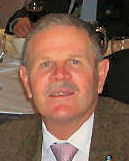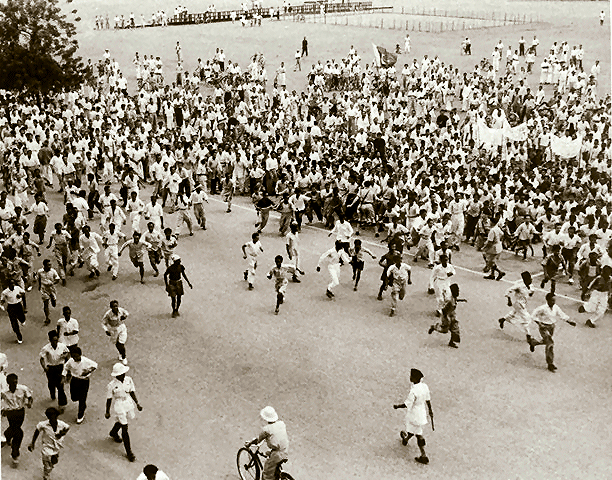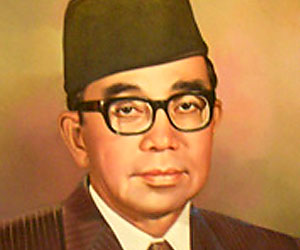|
|
|
Radschool Association Magazine - Vol 40 Page 16 |
|
Privacy Policy | Editorial Policy | Profit Policy | Join the Association | List of Members | Contact us | Index | Links |
|
Back Go to page: 1 2 3 4 5 6 7 8 9 10 11 12 13 14 15 16 17 18 19 20 Forward |
|
|
|
George Jones.
Air Marshal, George Jones retired on 13 January 1952 after a 10-year term as Chief of the Air Staff (CAS), the length of the term being second only to that of the first CAS, Air Marshal Sir Richard Williams, who had filled the post, off and on, for 17 years. When appointed in May 1942, Jones held the substantive rank of Wing Commander and was an acting Air Commodore. The first five years of his term were spent as an Air Vice-Marshal, although his Service had expanded in size during that time from 9000 to a peak strength in August 1944 of 182 000 personnel. He was promoted Air Marshal in January 1947, although by next year the RAAF had demobilized to only 8000 full-time members.
Twelve months after his retirement he was appointed a Knight Commander of the Order of the British Empire (KBE), starting the practice which saw each CAS for the next 30 years receive a knighthood.
|
|
Ballarat.
Col O’Brien.
Col O'Brien was at the
2011 Ballarat reunion which was held from the 23 March to the 27
March. After the event, the committee produced a little booklet in
which they got people to put down their memories of their time at
Ballarat and Col has sent us a copy. These are his memories.
In those days we still had copper boilers and they were not electric. At least I was fully experienced, having had the job of preparing the 'copper' every week when I was working on the sheep station. (A chore I hated incidentally). The 'Missus' out there was extremely fussy about the cleanliness of the boiler and if the copper had the least bit of oxide remaining on it, I had to do it again. We weren't that fussy at Ballarat but seeing as I had been drilled well, my copper was always clean. I cannot say the same for anyone else though. Also I had no trouble lighting a fire, but some of the blokes who were brought up with the notion that washing was part and parcel of secret women's business had to be helped. Some of course didn't want to know, and tried the ignoramus act a few times too many.
I saw one of the more
inexperienced bods burn one of his drab khaki shirts one day. He
tossed his clothes into the copper, then spent an inordinate amount
of time preparing a fire and trying to get it started. On standing
back gazing at the flames and admiring his new found skill, he
suddenly realised that he had not put any water in. He quickly
grabbed the hose and squirted it in but in the meantime the back of
one of his good shirts was scorched so badly that it was ruined. We
got issued with clothing free in those days, but unfortunately the
`L' Store Corporal was not to be convinced that the black burn mark
was fair-wear-and-tear.
Another who ruined his good khakis found himself in double trouble. His practice was to wash only when there was nothing left to wear in his locker, and to make it worse, because some of these were exceptionally dirty, his overalls and bedside mat, he added extra 'Rinso" (washing powder) to compensate. By this time we had been given 2 `Lighburn' front loading washing machines in the laundry so we were just a little concerned when the front lid was pushed up spewing out enormous quantities of soap suds which, by the time I got there, were oozing out the front door.
Then when he eventually extracted his wash he was amazed to find that his white singlets and underpants were a nice shade of grey. Similarly his khaki uniforms had assumed a mottled appearance. Panic was the order of the day until he was advised to do the whole wash over again, this time separating the linen from the rest, add no more than a handful of powder and finish off by thoroughly rinsing the clothes in fresh water. We live and learn.
Arthur “Gus” Comer
Gus Comer was there too,
he remembers a CO’s parade in November 1949. He says, that morning
we all turned out for parade in our summer drabs, first Tuesday of
the month. On this particular Tuesday, the parade ground was covered
with shiny white stuff, a frost like you’ve never s
Except for one dearly loved person!!
The parade that morning was inspected by our dear old friend, Wng Cdr Joseph Reynolds, the only man on the parade ground wearing a greatcoat.
|
|
During a commercial airline flight an experienced RAAF Caribou Pilot was seated next to a beautiful young mother with a baby in her arms. When the baby began crying during the descent, the mother began breast feeding the infant as discreetly as possible. The pilot pretended not to notice, and, upon disembarking, he gallantly offered his assistance to help with the various baby-related items. When the young mother expressed her gratitude, the pilot responded, "Well, that's a good looking baby, and he sure was hungry!" Somewhat embarrassed, the mother explained that her paediatrician said that the time spent on the breast would help alleviate the pressure in the baby's ears. The Air Force Pilot sadly shook his head, and exclaimed, "And all these years, I've been chewing gum."
|
|
Butterworth remembered.
Back in 2008, a lot of
people went back to Butterworth to celebrate the 50th
anniversary of the RAAF’s continuous combat support role in the
country and to commemorate the occasion, 324 Combat Support Squadron
produced a magazine in which they asked those
Air Marshall Geoff Shepherd, who was the Chief of Air Force from 2005 to 2008, was asked to write the forward for the magazine and being an old Butterworthington, he couldn’t resist adding some recollections of his own.
As a boggy pilot, he spent 3 years at Butterworth flying Mirages with 3 Squadron. He and his wife lived on the base in the married quarters, near the pool, and he says he can still remember the fascinating smells, the tastes of the variety of foods and the alluring way of life in the tropics.
Other fond memories include having a quite beer at the Hong Kong Bar in Chulia Street, grabbing a bargain at Ned Kelly’s on Penang Road, a suit or shirt from Wai Kee’s or a hair cut and shave at Vincents.
At its peak, the largest of the three Combat Support Squadrons, Base Squadron, had a total establishment of 601 persons and well over 1,000 locals were employed in various areas around the base and on the Island. The airfield supported a mixed population of over 2000 RAAF, ARA, British Army, RAF and RMAF people, it had a vehicle fleet of over 250 vehicles of different size and types, and administered over 1,000 married quarters.
4 RAAF hospital was the only RAAF hospital that had its own maternity wing and the base had its own radio station (known as radio mouth). RAAF Butterworth was once the RAAF’s largest base.
Ted Ilton.
One of the Air Force’s great characters, Wing Commander Ted Ilton, was posted to Butterworth on the second wave in July 1960. He recalls his time spent there.
He openly admits a posting to Malaysia was on everyone’s preferences because of the great conditions of service, opportunity for indulgence travel in Asia and in FLTLT Ilton’s case, a very pleasant sea voyage, first class, on the Flotta Lauro Line’s M.V. Roma. In those days a number of ships were on the Europe/Australia run jammed with migrants and invariably the ships were half empty on the return voyage so the 14 day trip was a great luxury for Ted, his wife Mattee and their young children Gary and Robyn.
By 1960 Base Squadron Butterworth was ‘up and running’ and Ted fitted quickly into the routine. His fellow admino was a pilot (in those days the RAAF had a surplus of pilots) who would slip off for an hour or so to keep his flying skills current. The extra workload created by the flying Admino did ‘erk’ the staff a bit as the Base was extremely busy at that time.
The extra workload placed on Ted by the “flying Admino” didn’t go unnoticed and the OC, Air Cdr Phil Ford appointed him the protocol officer for the visit of the King and Queen of Thailand, the first visit to Malaysia by foreign royalty and in those days key positions in the military were given to British or Australian senior officers. For example the Malaysian CNS was Commodore Bill Dovers RAN and the CAS was a RAF Gp Capt. Ted had to gather all his diplomatic skills to ensure the visit’s success.
There was great concern
that the Royals would not get wet on departure on the Malaysian
Ted said he recalled
another incident which had a young pilot very smartly sent back to
Australia on the next available Hercules. The OC at the time was Air
Cdr Geoff Hartnell and he had arranged for a permanent memento to be
presented to the departing RAF Commander. An exquisite pennant
highlighting the three RAAF squadrons had been carefully embroided
and it was planned to present it at a formal dining in night. With a
great flourish, the OC unveiled the pennant to the assembled.
However, the young pilot who didn’t like the Poms, had arranged for
‘ALL P0MMlES ARE BASTARDS’ to be emblazoned on the
Butterworth married quarters, 1966
He also recalls another incident — typical of the Butterworth lifestyle in the early sixties. The Wng Cdr SMO at the time owned a rather ‘swish’ yacht and he wanted to lift it on the dry dock for maintenance. In those days the SMO was an officer of considerable influence and he was offered the use of the multi-wheeled, heavy lift crane, to carry out the task. While the crane was being placed in an appropriate position for the lift, it got stuck in the soft sand leaving the panicking driver attempting to extricate the machine before a rising tide. In spite of his frantic efforts the tide forced the driver to leave the crane to its fate. With a normal diesel motor there might not have been a problem, but the crane’s wheels were independently driven by electric motors. The salt ingestion resulted in a few red faces and some very embarrassing explanations!
As a keen golfer Ted was
frustrated there was little opportunity to hone his skills. There
was a small course on Penang Island, which was always busy, and a
couple of local
When Ted returned 10 years later the course had ‘grown’, there were 18 tees, nine greens with bunkers, a lovely clubhouse and a caddy shed. Today it is on the tourist list as a “must see”.
Another perk of a posting to Malaysia was buying a car. Ted recalled during his first posting the wealthy Chinese always wanted the latest American cars. This meant there were a considerable number of second hand American cars on the market which the locals could not afford. Ted bought a beautiful four year old Dodge for 400 pounds. He ended up taking it back to Australia on the Orient liner, Oronsay, and running it for another 8 years. And on his second posting to Butterworth he bought back a Humber Super Snipe.
|
|
Ron Ledingham.
On 17 December 1967 our chartered Qantas B707 aircraft landed at Butterworth Air Base; I was just 20 years old. The doors opened and we were hit with a wall of very humid and hot air, the likes of which I had never experienced before - 32 degrees, warm and humid. The aircraft was full of RAAF personnel posted to Butterworth; in the main they were family units and there was only two or three who were single; I being one of them.
Some 40+ years later, 15 January 2008, a Wednesday, 32 degrees warm and humid, not much change. My wife and I have been invited to the 50 ' anniversary lunch for 324 CSU at the "Boatie" which is now known as the Australian Sports Club. The memories come flooding back. We are standing alongside Terry Taft, a long term local Malaysian Chinese friend of mine who has a sign writing business which has served the Base and local community with signs and paintings for many years.
In 1967 I was posted to RAAF Base Squadron Radio Section Butterworth as a Ground Radio technician to work on the then installed GCA radar system known as an AN/CPN-4 which I had been trained on at USAF Billoxi Mississipi USA some months before. I was young, naive and very excited to be in Malaysia. Remember that this was a time when the Vietnam War was at its peak; communist terrorism activities were very common in Malaysia and generally this region was rather unstable. I had come from the protected environment of Moree country north-western NSW; joined the RAAF as a radio apprentice on 16 January 1964 - what a contrast.
|
|
|
|
|
|
I still vividly remember my arrival and time in Malaysia from Jan 1967 to June 1970. I celebrated my 21st birthday in Penang on 23 November 1968 and not long after married Suzy a local Malaysian Hokkien Chinese girl on 19 April 1969 in the local chapel on the base near the base swimming pool.
As was the custom, on my first night, one of the RAAF staff who also worked on the GCA radar (Ray Noak), took me out on the town. I still have a very clear memory of driving along a jungle lined road in pitch darkness when the headlights of the vehicle we were in, lit up a road sign which was a skull and cross bones. I was already nervous and this really worried me. When I asked my companion he informed me that this sign was to indicate where a terrorist attack had taken place and people had been killed; which was not true, but how was I to know any different. I was very worried the rest of that evening. The next day I found out the real meaning of the sign which was just a caution sign for a section of bad road prone to traffic accidents.
In 1967 the base was a very active place and the RAF still had a strong presence on the base. I lived in the single quarters on the base directly behind the airman's mess. We had a "pet" monkey chained to a tree near the quarters, could get a hair cut for RM1 and had an exchange rate of about 3.5 to 1. I also recall the RAF Malcolm club, the NAFI and Sheriffs general shop. We were also provided with a hut "room boy" who, for a low fee would wash, iron, polish our shoes and clean our rooms every day. I also recall the light bulbs installed in our small cupboards which were to reduce the growth of fungus on our cloths in the warm, humid conditions.
Not far from the base outside the perimeter fence we also frequented the Jumbo Bar in Robina Park and the Butterworth Cafe both providing an air conditioned environment with cold beer and European as well as local food; a home away from home for lonely RAAF single servicemen.
All new comers were provided with a familiarisation brief in their first week. I recall that I was there to work on the GCA radar which sat at one end off to one side of the air strip generally remote from the rest of the base infrastructure. During the introductory brief it was mentioned that the most vulnerable facility on the base was the GCA radar, again i was very fearful for my safety.
During 1969 the old GCA radar was to be decommissioned and replaced with a Plessey PAR/AR1 system by the RAF In the intervening period I then worked on the Base Radio Transmitters and Receiver station alongside the Boatie. Part of my duties were to also provide technical support for the installations on the remote bombing site islands on the north west coast near the Thailand border known as Bidan and Song Song - very interesting set up. We used to do a rotating shift duty roster for about one to two weeks at a time as required to service the island installations. Transport to and fro was via RAF SAR patrol boats fitted with huge Rolls Royce engines-magnificent.
My first period of duty on the island was just before I was to marry. An RAF serviceman, married with a few children, decided to go for a moonlight swim with one of the RAAF members following a day of heavy drinking. Later that evening he was dragged from the water dead with indications that he may have trodden on a stone fish as one of his feet had numerous puncture marks. Only the day before he had encountered local fishermen's nets with the boats which had fouled the propeller. Fishermen had been warned many times not to lay their nets in our area of operations. The RAF serviceman took to the nets with a small axe and cut them to shreds. To this day I do not really know if he died as a result of a genuine accident or he was "disposed of by the local fishermen? Life was like that back then.
Not long after I married we were accommodated in the RAAF Hostel in Penang as there was a shortage of suitable on base married quarter housing for us. Along came May 13th 1969, the race riots which resulted in many racial fights and many dead as well as a full 24/7 curfew where the orders were shoot first, ask questions later. As I was residing in the Hostel and had an RAAF drivers licence I was ordered to work with local RAAF Service Police as a driver to leave the Service Police free to use their weapons as needed to carry out their responsibilities of both enforcing the curfew and protecting Australian personnel. If I was scared upon my arrival in Malaysia, it was nothing to how I felt as we drove around a totally deserted Penang in the dark evenings not knowing what to expect.
Australian servicemen and women were instructed that under no circumstances were they to leave the immediate confines of their yard and if they had a need for assistance they were to leave a front external light on and a towel draped over front gate.
During this period
communists were still active. One very upsetting incident was when a
At this time there was also a fairly large contingent of Gurka servicemen under the command of a British Army Officer. On one dark evening whilst patrolling the curfew I recall that this bunch of Gurkas came out of the pitch black and approached us, we had absolutely no idea they were there. Thank heavens they were on our side. During the curfew, emergency plans for a mass evacuation back to Australia were underway and I recall the RAAF Hostel in Penang being stocked with emergency rations.
I still have a copy of the book “May 13, Before and After” written by the then Malaysian Prime Minister who became known as the father of Malaysia, Tunku Abdul Rahman.
I was posted back to Australia in June 1970 and decided I would undergo some studies to better myself. In March 1981, I was posted back to 3 Sqn in Malaysia but by this time I had completed a Degree of Engineering and was a Flt Lt EngElec. I did another 3 years at Butterworth with 3 Sqn and eventually retired from the RAAF in 1987.
When the tsunami struck SE Asia in December 2004, my wife and I were in Penang and were having breakfast at a café in Gurney Drive. We had only finished breakfast and left the café when the water hit that area, killing several Malaysians just north of where we had been sitting.
I still have very fond memories of my time at Butterworth – before I went there the strongest curry I had ever eaten was Keens curry – now the only one we use is Durian. What is not to love about their vast array of hot and spicy foods.
|
|
|
|
|
|
|
|
Back Go to page: 1 2 3 4 5 6 7 8 9 10 11 12 13 14 15 16 17 18 19 20 Forward |
|
|
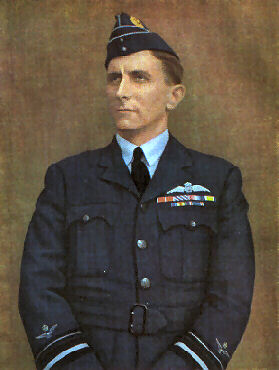
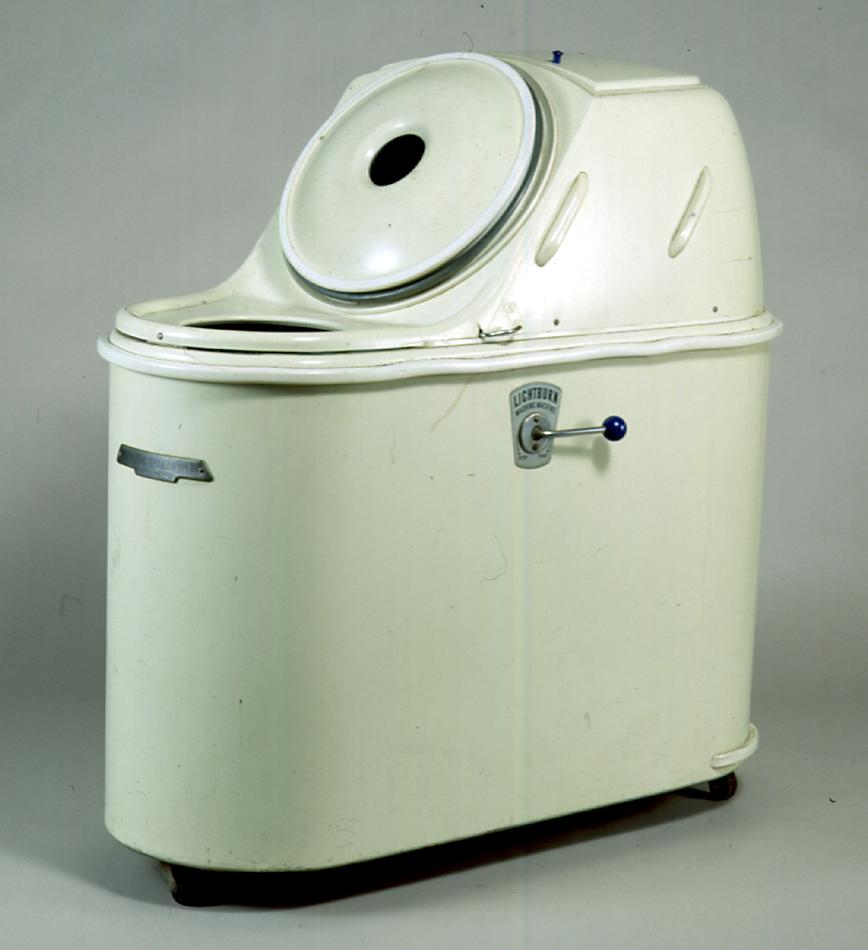
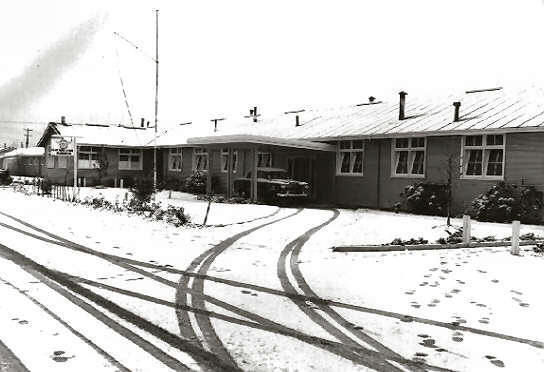 een,
the temperature was several degrees below freezing and everyone was
very very cold and very unenthusiastic.
een,
the temperature was several degrees below freezing and everyone was
very very cold and very unenthusiastic. 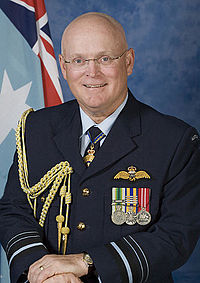 involved to remember
their experiences.
involved to remember
their experiences. 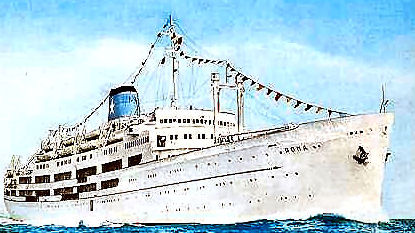
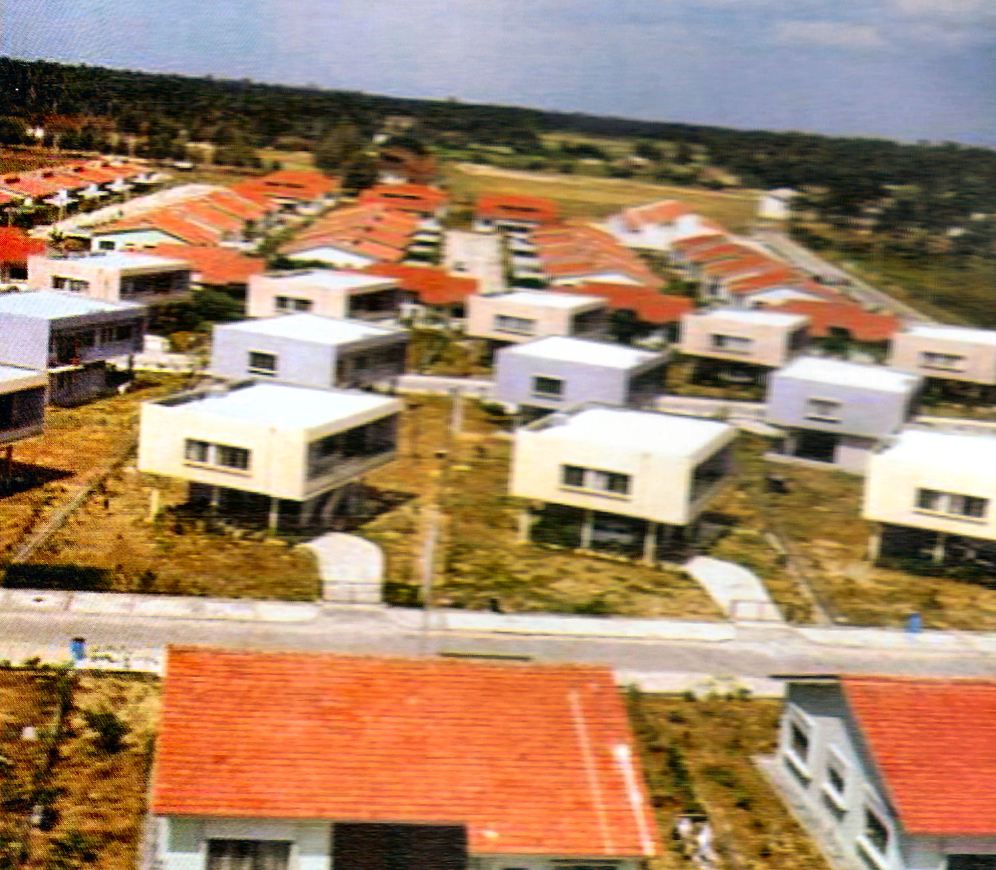 back facing the dining throng. The RAF Wing Commander thought it was
a great joke but the OC was not amused. The young pilot found
himself back in Australia with his antics duly noted on his docs.”
back facing the dining throng. The RAF Wing Commander thought it was
a great joke but the OC was not amused. The young pilot found
himself back in Australia with his antics duly noted on his docs.”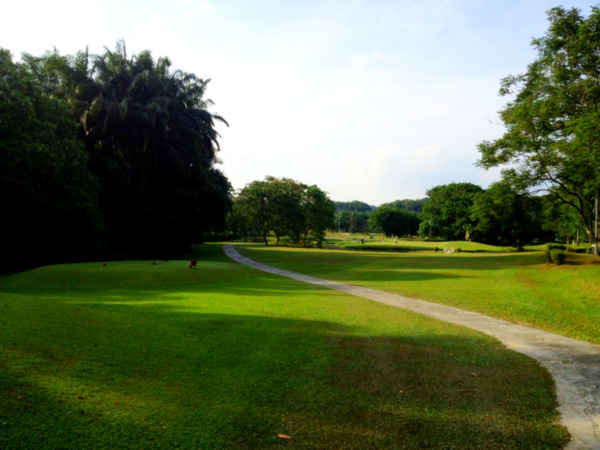 plantation managers had built a few holes on their land, which
officers occasionally used. So it was put to the Base Sqn CO, Grp
Capt Jack Dowling, to build a three-hole course on some vacant land.
He agreed and although it was a little boring playing three holes,
six times, it did provide an outlet for golfers. More importantly
the golf club became the centre of social life on Saturday night.
plantation managers had built a few holes on their land, which
officers occasionally used. So it was put to the Base Sqn CO, Grp
Capt Jack Dowling, to build a three-hole course on some vacant land.
He agreed and although it was a little boring playing three holes,
six times, it did provide an outlet for golfers. More importantly
the golf club became the centre of social life on Saturday night.
